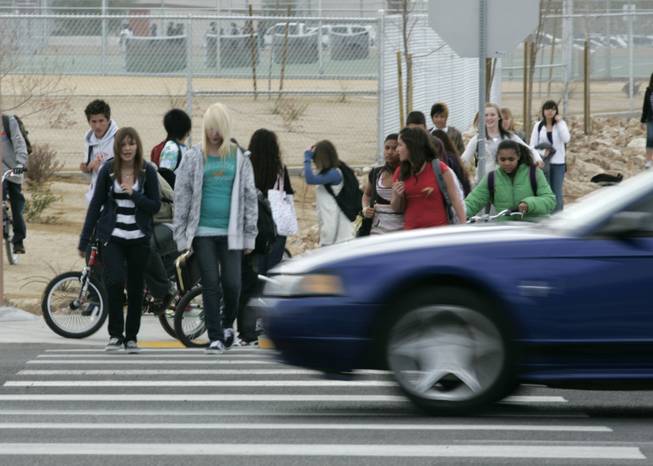
A car passes through a crosswalk Thursday as Faiss Middle School students prepare to cross Fort Apache Road, a known hot spot for speeding.
Friday, Feb. 22, 2008 | 2 a.m.
Seventh grader Crystal Vo was in the crosswalk at Fort Apache Road and Maule Avenue when she dropped her textbook.
Crouching to retrieve it, she looked up to see a white car hurtling toward her.
“He hit the brakes hard and stopped in the road,” Crystal said, recalling the episode, which occurred a few weeks ago during her morning walk to Faiss Middle School. “I wanted to scream, ‘Are you crazy? The speed limit is 25 miles! There are kids here!’ ”
The problem, said her classmate Aubrey Shirley, is that drivers just don’t care.
The Fort Apache-Maule intersection is one of several hot spots under close watch by Clark County School District Police, who, armed with new authority, are writing more traffic citations than ever.
The 2007 Legislature clarified that School District Police have the authority to cite drivers for violations on streets adjacent to campuses without having to involve other police departments.
In the school year’s first half, August through January, School Police on streets near schools wrote 676 citations, about double the number in the same period of 2006-07, School Police Lt. Ken Young, the department’s spokesman, said.
There’s no profit incentive for School District cops to write tickets, he said. The fines collected for tickets they write go into the coffers of the city or county traffic court that processes the tickets.
“This does not generate revenue for us, and that’s not our concern,” Young said. “Our concern is the safety of our kids.”
During the 2005-06 academic year, 32 students were hit by cars near school campuses in Clark County. Two of them died. In 2006-07, the number of incidents dropped to eight. Numbers for 2007-08 were not available.
Look Out Kids About, a community safety coalition, says an aggressive public education campaign, combined with more enforcement by all police, is one of the reasons for the sharp decline in injuries in recent years.
“We’ve really worked hard to get the message out there,” said Maggie Saunders, the coalition’s vice president for public safety. “We have some very dedicated parents.”
The coalition was formed after the October 2005 death of 11-year-old Amanda Aragon, killed by a hit-and-run driver while she was using a crosswalk near Sawyer Middle School. The coalition’s governing board includes representatives of the School District, municipal agencies and the Nevada PTA.
Having School Police able to more easily write tickets “is a huge deterrent,” Saunders said. “Every little bit helps.”
Metro Police spokesman Martin Wright said having School Police more actively enforce traffic laws has “made a major contribution.” School Police are more likely to be patrolling the streets adjacent to campuses, “so having them out there doing more traffic enforcement frees us up to respond to accidents, emergencies and calls for service,” Wright said.
If the School District Police Department were fully staffed, officers would likely write even more tickets and have more time to respond to principals’ requests for help, said Phil Gervasi, president of the Clark County School Police Officers Association.
“We get calls every day from schools asking for enforcement,” Gervasi said. “We just don’t have the manpower.”
The force has 115 officers and 30 vacancies.
For now, School Police have no plans to stake out the traffic hot spots and wait for violators to buzz by. “That’s something that could happen in the future, provided we get our staffing where it needs to be,” Young said.
Another shortage is hampering efforts to keep kids safe around schools — that of crossing guards. Metro, Henderson and North Las Vegas police are responsible for hiring and paying crossing guards for the elementary schools in their jurisdictions, but consistently complain that it is very difficult to keep all the positions filled.
The district’s middle schools, even those, like Faiss, that are in known trouble zones, aren’t staffed with paid crossing guards.
Kathy Free, a teacher at Faiss who has a daughter in the sixth grade at the school, said she would “absolutely not” let her daughter walk to or from school.
After too many close encounters between her students and speeding motorists, Faiss Middle School Principal Joy Lea formed her own traffic squad, made up of herself, an assistant principal and a dean.
They began patrolling the intersection of Fort Apache Road and Maule Avenue, the walking route for many Faiss students every morning and afternoon. The dangerous driving continued in that area, so she called School Police, and later Metro, for help.
The result? Flashing signal lights were installed a month ago to try to get the drivers traveling on Fort Apache to slow down and watch for pedestrians.
Lea said every school community meeting ends with a reminder to be careful on the roads. Fliers go home regularly to parents urging the same.
But students who flout basic safety protocol aren’t helping matters either.
Outside Faiss at 7:30 a.m. Thursday, a group of boys on dirt bikes whizzed down Fort Apache before making a wide left turn onto Maule. Some of the bikers stayed on the sidewalk, while others spilled into oncoming traffic, weaving in and out of cars waiting at the intersection.
“Did you catch that?” one driver said, rolling down his window and pointing to the dirt bikers, now racing toward the middle school’s parking lot. “Not very cool.”
Emily Richmond can reached at 259-8829 or at [email protected]

Join the Discussion:
Check this out for a full explanation of our conversion to the LiveFyre commenting system and instructions on how to sign up for an account.
Full comments policy